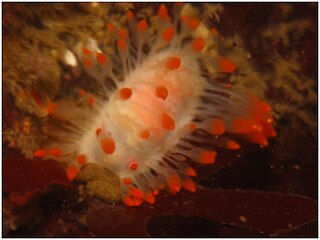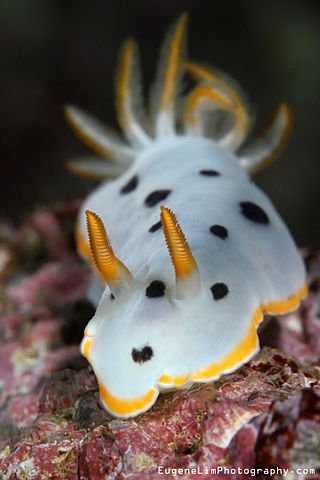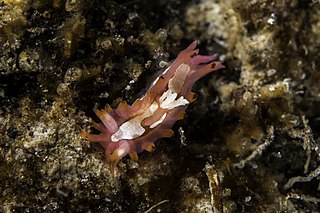
Diaulula sandiegensis, commonly known as the San Diego dorid or the ringed dorid, is a species of sea slug or nudibranch, a marine gastropod mollusc in the suborder Doridina and the family Discodorididae.

Doriprismatica sedna is a species of colorful sea slug, a dorid nudibranch, a marine gastropod mollusk in the family Chromodorididae.

Mexichromis trilineata is a colourful species of sea slug, specifically a dorid nudibranch. This marine gastropod mollusc is in the family Chromodorididae. In 2012 the genus Pectenodoris was included into Mexichromis.

Limacia cockerelli is a species of sea slug, a dorid nudibranch, a shell-less marine gastropod mollusc in the family Polyceridae.

Cadlina flavomaculata, common name the yellow-spot cadlina, is a species of colourful sea slug, a dorid nudibranch, a shell-less marine gastropod mollusk in the family Cadlinidae.

Cadlina laevis, common name the white Atlantic cadlina, is a species of sea slug, a dorid nudibranch, a shell-less marine gastropod mollusk in the family Cadlinidae.

Hopkin's rose nudibranch is a species of sea slug, specifically a dorid nudibranch, a marine gastropod mollusc in the family Goniodorididae. Previously known as Okenia rosacea, this species was reclassified as Ceratodoris rosacea in 2024.

Thordisa is a genus of sea slugs, dorid nudibranchs, shell-less marine gastropod mollusks in the family Discodorididae.

Chromodoris orientalis is a species of colourful sea slug, a dorid nudibranch, a marine gastropod mollusc in the family Chromodorididae. Sea slugs are generally very beautifully colored organisms with intense patterns and ranging in sizes. The Chromodoris orientalis specifically is a white sea slug with black spots in no particular pattern with a yellow, orange, or brown in color ring around its whole body and on its gills. There is much discussion on where it is found, what it eats, how it defends itself without a shell, and its reproduction methods. This is all sought after information because there is not much known about these animals.

Felimare californiensis, common name the California blue dorid, is a species of colourful sea slug or dorid nudibranch, a marine gastropod mollusk in the family Chromodorididae that eats dysideid sponges.

Hypselodoris dollfusi is a species of colourful sea slug or dorid nudibranch, a marine gastropod mollusc in the family Chromodorididae. After being described initially in 1933 by Pruvot-Fol, this species was not seen again until its rediscovery in 2000 in the Sea of Khorfakkan, United Arab Emirates.
Mexichromis antonii is a species of sea slug, a dorid nudibranch, a shell-less marine gastropod mollusk in the family Chromodorididae.

Mexichromis katalexis is a species of sea slug, a dorid nudibranch, a shell-less marine gastropod mollusk in the family Chromodorididae.
Mexichromis tura is a species of sea slug, a dorid nudibranch, a shell-less marine gastropod mollusk in the family Chromodorididae.

Okenia angelensis common name Los Angeles Okenia, is a species of sea slug, specifically a dorid nudibranch, a marine gastropod mollusc in the family Goniodorididae.

Okenia liklik is a species of sea slug, specifically a dorid nudibranch, a marine gastropod mollusc in the family Goniodorididae.
Okenia mediterranea is a species of sea slug, specifically a dorid nudibranch, a marine gastropod mollusc in the family Goniodorididae.
Trapania goslineri is a species of sea slug, a dorid nudibranch, a marine gastropod mollusc in the family Goniodorididae.

Ancula lentiginosa is a species of sea slug, a dorid nudibranch, a marine gastropod mollusc in the family Goniodorididae.
Thordisa rubescens is a species of sea slug, a dorid nudibranch, shell-less marine opisthobranch gastropod molluscs in the family Discodorididae.















